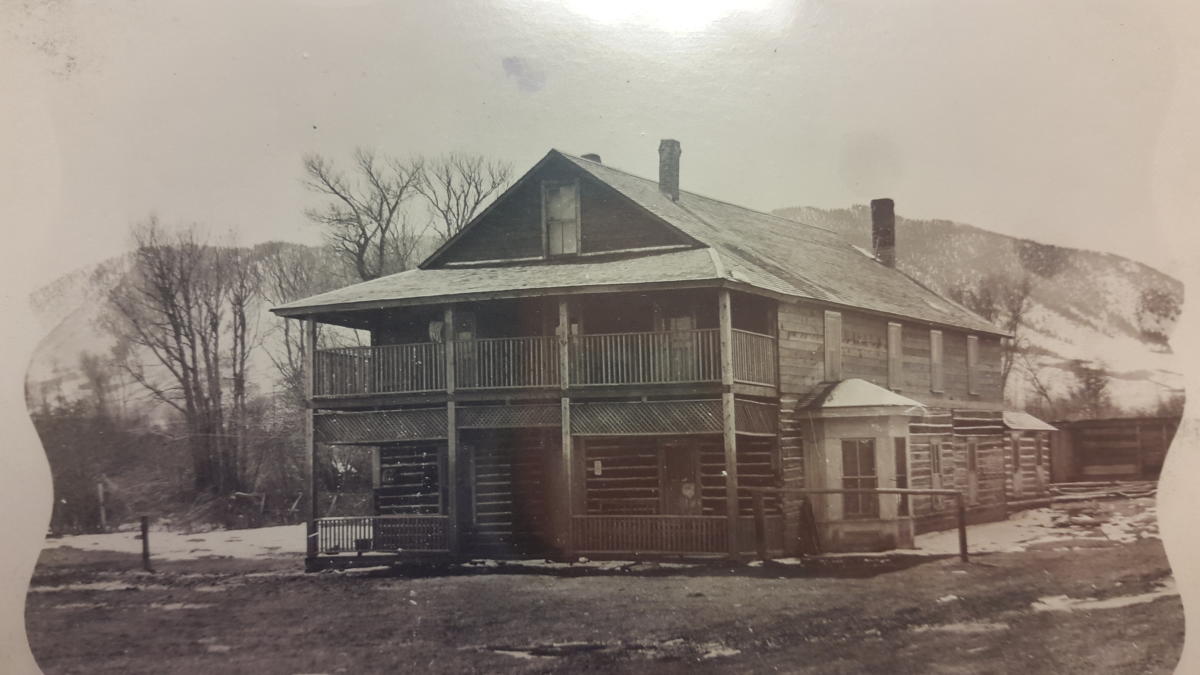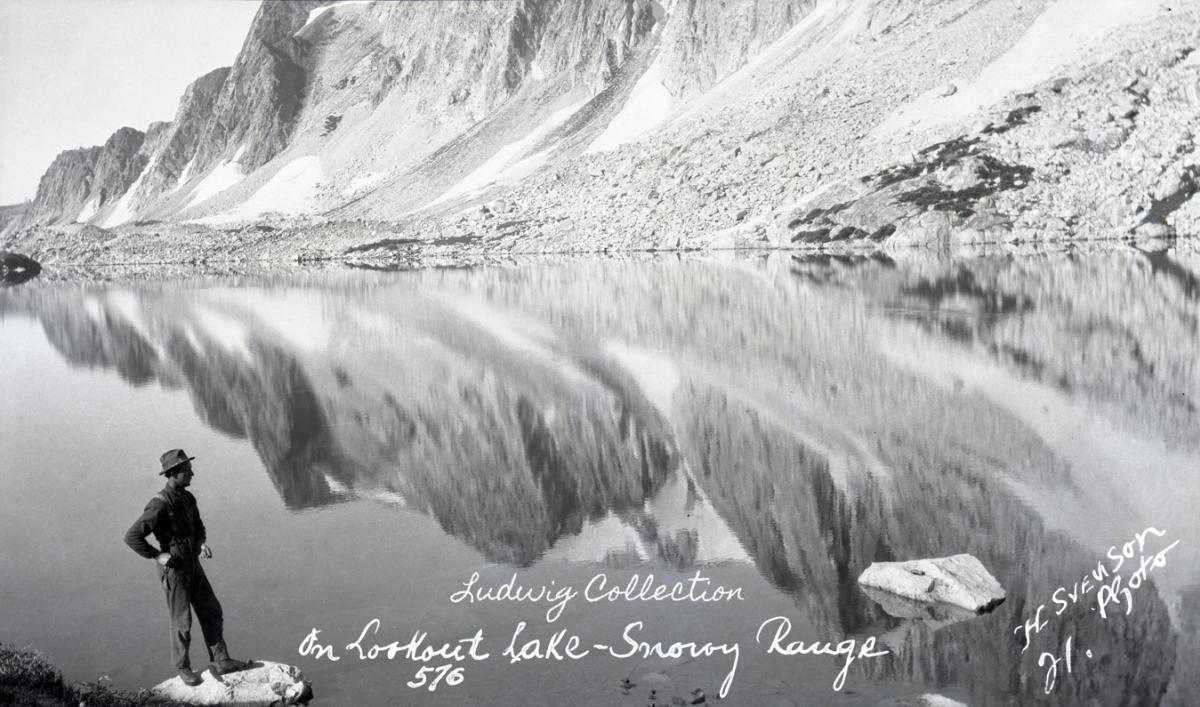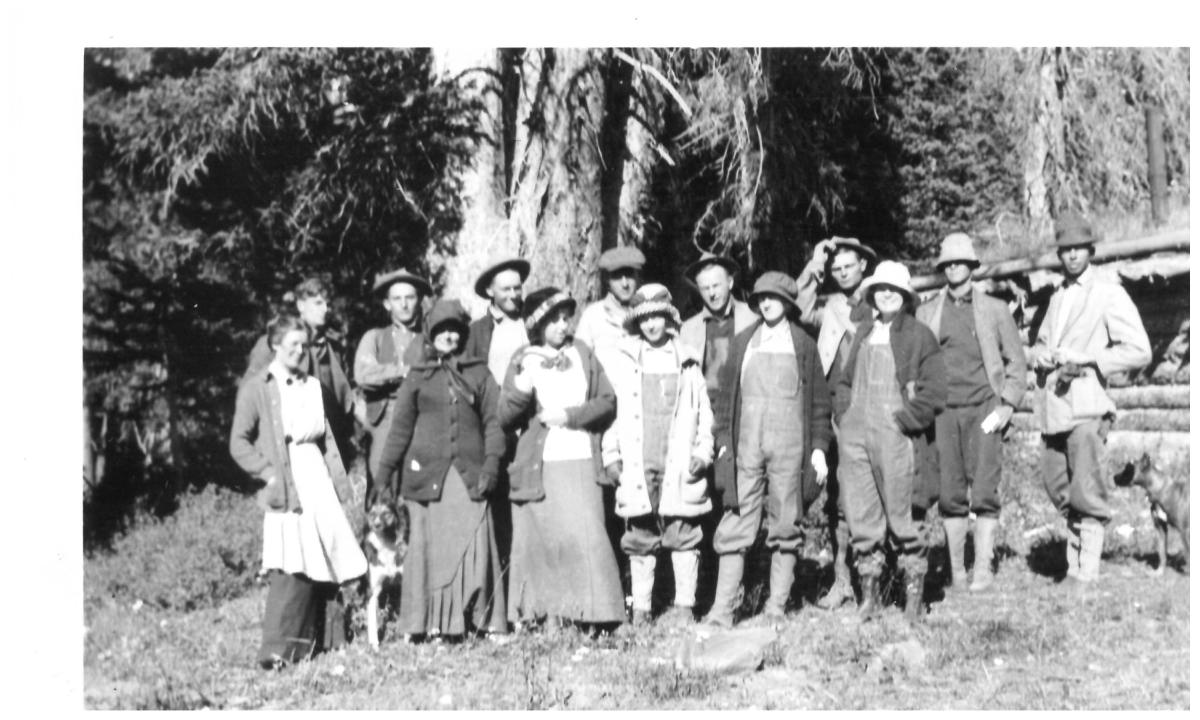The photo above is of the town of Centennial, c.early 1900s (photo is part of the Ludwig Collection, used with permission from Anne Brande of Ludwig Photography)
Just a few miles west of Laramie, on Highway 130, lies the Centennial Valley and the town of Centennial. The Valley is nestled between Sheep Mountain and the Snowy Range (part of the Medicine Bow Range). The Little Laramie River flows through the valley and provides a green oasis after miles of open prairie. Founded in 1875, Centennial has a vibrant history and embodies the spirit of the old west.
Early History and Settlement
 An early settlement near Centennial, Wyoming (photo is part of the Ludwig Collection, used with permission from Anne Brande of Ludwig Photography)
An early settlement near Centennial, Wyoming (photo is part of the Ludwig Collection, used with permission from Anne Brande of Ludwig Photography)
Of course, the original inhabitants of the Centennial Valley were Native Americans. The Cheyenne, Arapaho, Ute, and Lakota (among others) hunted in the Centennial area and made use of the abundant natural resources. Many tribes also traveled through the area on their way to trade with other tribes, and later with European fur traders and explorers (Before Wyoming: American Indian Geography and Trails, n.d.).
The first Europeans, French fur traders, entered Wyoming as early as the 1740s. Attracted by the promise of a land rich in furs—particularly beavers—fur traders and trappers gradually explored the rivers and streams of Wyoming and opened a vast trade network. French trader Jacque La Ramie explored the Laramie River system, which would eventually be named for him, and trapped in southeastern Wyoming between 1820 and 1821 (The Fur Trade in Wyoming, n.d.).
After the passage of the Pacific Railways Act and the Homestead Act in 1862, the Centennial Valley began to experience an increase in settlement and development (Centennial and Library History, n.d.). The earliest settlers in the Centennial area were primarily homesteaders and ranchers. Land records show that homesteaders and ranchers were staking claims as early as the late 1860s. There were several ranches in the Centennial Valley already by the late 1800’s. A “Pete Christiansen” is mentioned in an early obituary as being the first settler in the Centennial Valley (National Register of Historic Places, Flying Horseshoe Ranch, 2000).
Early ranches included: the Buckeye Ranch, possibly established as early as 1868 by Charles Bussard; the Bow Fiddle Ranch, established in 1872 by James May; the 91 Ranch, possibly established in 1872 by George and Josh Brown (land records show 1879); the Flying Horseshoe Ranch, established by Mads Wolbol in 1878; the Deerwood Ranch, established in 1881 by Tom Bird; the Baily Ranch, established in 1882 by Jason Baily; and the Vee Bar Ranch, established in 1883 by Theodore Brubaker (National Register of Historic Places, Flying Horseshoe Ranch, 2000).

The Lodge at the Vee Bar Guest Ranch (photo used with permission from Kari Kilmer of the Vee Bar Guest Ranch)
Some of these ranches are still in operation today, although most have changed hands several times, and some serve new purposes. The Vee Bar Ranch is now the Vee Bar Guest Ranch and provides an amazing place to stay and experience the Old West. The Deerwood Ranch has become the Deerwood Wild Horse Ranch and Ecosanctuary, providing a home for Wyoming’s wild mustangs and opportunities for guests to tour the ranch and learn about these beautiful animals.
The Timber Industry
 Lookout Lake in the Snowy Range (photo is part of the Ludwig Collection, used with permission from Anne Brande of Ludwig Photography)
Lookout Lake in the Snowy Range (photo is part of the Ludwig Collection, used with permission from Anne Brande of Ludwig Photography)
Logging was another early industry that brought people and progress to the Centennial area. A railroad tie camp was established in the mountains near Centennial to supply ties to the railroad in their efforts to build the Transcontinental Railroad. The timber industry continued to be an important industry in Centennial even after other industries, like mining, declined (Centennial and Library History, n.d). In fact, the timber industry was so vital, that a seasonal P.O.W. camp was established in Centennial during WWII to help with the critical labor shortage caused by the war. The Centennial camp was one of 17 seasonal P.O.W. “branch” camps in Wyoming (in addition to the two main camps in Cheyenne and Douglas) to supply agricultural and timber labor. German, Austrian, Czechoslovakian, and Polish P.O.W.s worked for civilian companies that paid the U.S. Government the same rate they would have paid for civilian labor (Nineteen Camps: WWII P.O.W.s in Wyoming, n.d.).
The Mining Industry
Along with ranching and logging, mining soon became an important industry in the Centennial area. Gold was discovered in 1868 in what is now known as More’s Gulch, where Douglas Creek flows into present-day Rob Roy Reservoir. This led to the creation of the Douglas Creek Mining District yielded a total of about 4,000 ounces of gold. Gold was discovered along the Centennial Ridge in 1874, and the Centennial Mining District was founded in 1875 (Albany County, WY, Wyohistory.org, n.d.).
By 1876, the newly minted town of Centennial was christened in honor of the American Centennial. The promise of gold and other minerals encouraged the development of business and industry in the area and the town began to grow. Unfortunately, the gold rush was rather short-lived, by 1908 the promise of gold had severely diminished. There were other metals mined near Centennial, including copper, silver, and platinum, but none proved to be very fruitful (Centennial and Library History, n.d.).
The Railroad
The Railroad had been important for Centennial’s early development as a source of timber for railroad ties. During the mining boom, other businessmen saw the potential of extending the railroad to Centennial. In order to accommodate the mining and lumber industries in Centennial, Isaac Van Horn and Fred A. Miller formed the Laramie, Hahn’s Peak, and Pacific Railway Company in 1901. By the time the railroad reached Centennial in 1907, mining was coming to an end and the railway turned south to Walden, Colorado. The railroad tracks have long since been removed, but the original Centennial Railroad Depot can be seen today at the Nici Self Museum (Albany County, WY, Wyohistory.org, n.d).
Tourism
The Centennial area had long attracted hunters, campers, and sightseers. After the railroad reached the town, railroad “excursions” became popular with tourists. The first such excursion took place on July 4th, 1907, and celebrated the completion of the railroad with a golden spike ceremony, a picnic, and a dance. About 1,200 passengers rode the train to and from Centennial that day (Albany County Historical Society, 2021).
 Brooklyn Lake Lodge (photo is part of the Ludwig Collection, used with permission from Anne Brande of Ludwig Photography)
Brooklyn Lake Lodge (photo is part of the Ludwig Collection, used with permission from Anne Brande of Ludwig Photography)
Hotels and Lodges
The oldest hotel in Centennial is The Mountain View Hotel. The hotel was completed in 1907, in time for the arrival of the railroad. The hotel was part of a plan by Isaac Van Horn and the railroad to turn Centennial into a business and tourism destination. The original hotel boasted 20 guest rooms, a restaurant, and imported furniture, and was “the pride of Centennial.” The hotel was purchased by Gustav Sundby and his wife in 1912. The Sundby’s ran the hotel and restaurant until the 1940’s. The hotel changed hands several times and served other purposes over the years. Today, the Mountainview Hotel has been restored and operates as a hotel once again. The restaurant is soon to be re-opened as a coffee shop and café (The Mountain View Hotel, n.d.).
While the Mountain View Hotel might be the best-known, it is not the only historic accommodation near Centennial. Brooklyn Lodge and Sand Lake Lodge opened in 1924, followed by Libby Lodge (now the Snowy Mountain Lodge) in 1925. These lodges originally operated as resorts catering to tourists hoping to enjoy the beauty and tranquility of the Snowy Range. Hunters, sightseers, and skiers all stayed in these wonderful hotels. The Snowy Mountain Lodge (formerly Libby Lodge) is now an event center, hosting weddings, meetings, and other events, however, it still retains its original rustic charm. The Brooklyn Lodge is also still operating and hosts guests looking to enjoy the mountains and the unique history (The Mountain View Hotel, n.d.).
Dude Ranches

A cabin at the Vee Bar Guest Ranch, originally a homestead cabin that was moved to the ranch and known as "Aunt Kate's Cabin" (photo used with permission from Kari Kilmer of the Vee Bar Guest Ranch)
Dude ranches have long been a fixture of the West. While their “heyday” was in the 1920s, Howard, Alden, and Willis Eaton are often credited with creating the first dude ranch near Medora, ND in 1879. The success of their enterprise led them to start a new ranch in 1904 in Wolf, WY (west of Sheridan). There were many dude ranches in Wyoming at the turn of the century. The ranches offered tourists a place to stay while they hunted, fished, camped, and explored nature (Romancing the West, WyoHistory.org, n.d.).
The Vee Bar Guest Ranch, as mentioned above, is one such ranch in the Centennial Valley. The original lodge was built by Lionel Sartaris of England in 1891, after purchasing the land from homesteader, Theodore Brubaker. The land was operated as a cattle ranch under Sartoris and, subsequently, Susan J. Fillmore. (National Register of Historic Places, Vee Bar Ranch and Lodge, 1986). It was later leased, and eventually purchased in 1911, by Gordon Wright to serve as the headquarters for the stage line from Laramie to mines in the Centennial area. The home served as a stop on the stage line and Mrs. Wright served meals for 35 cents. By 1907, the Laramie, Hahns Peak & Pacific Railroad had come through the property, and the Wrights decided to open add eight bedrooms onto their home for the fishermen and tourists who were frequenting the ranch. The Vee Bar Guest Ranch was born! (Spring, 1974)
The ranch was later purchased by Leonard and Lillian Hein in 1938. The Hein’s continued to operate the “dude” ranch and also ran a cattle and hay operation. The ranch has changed hands several times over the years, and served other purposes (National Register of Historic Places, 1986). It is now owned and operated as the Vee Bar Guest Ranch by Brent and Kari Kilmer.
Centennial Today
 A photo of campers enjoying the Snowies, c. 1911-1914 (photo used with permission from Kari Kilmer of the Vee Bar Guest Ranch)
A photo of campers enjoying the Snowies, c. 1911-1914 (photo used with permission from Kari Kilmer of the Vee Bar Guest Ranch)
Today Centennial still retains its rustic charm and small mountain-town atmosphere. The days of the railroad, mining, and timber industries are over, but Centennial’s tourist industry continues to thrive. Centennial caters to tourists, hunters, and locals looking to enjoy the beauty of the Snowy Range Mountains and all the beauty and wonder they have to offer.
Centennial still serves as a great base for venturing into the mountains and the Medicine Bow National Forest. Sightseers can follow the Snowy Range Scenic Byway for stunning mountain views and opportunities to see wildlife. Hikers, mountain bikers, snowshoers, cross-country skiers, and snowmobilers can explore the numerous trails that crisscross the area. Downhill skiing enthusiasts can take enjoy the Snowy Range Ski Area, just outside Centennial. Plan a tour of the Deerwood Wildhorse Ranch and Ecosanctuary, for an unforgettable experience.
Visitors to the town of Centennial can stop by The Country Junction for Wyoming gifts and homemade ice cream. Or, learn more about Centennial’s amazing history with a visit to the Nici Self Museum. The museum was founded in the early 1970s by the Centennial Valley Historic Society, to learn more about the amazing history of the Centennial Valley. Don’t forget to eat! Enjoy a meal at The Old Corral Steakhouse, The Trading Post, or The Bear Bottom Bar & Grill.
In short, there is so much to see and do in and around Centennial, Wyoming. Understanding the fascinating history of the area certainly adds a layer of richness to a visit to the town. Come experience Centennial today!
A special thank you to Kari Kilmer of Vee Bar Guest Ranch and Anne Brande of Ludwig Photography for their invaluable assistance with research and historical photos.
You may also enjoy: Top 10 Historic Businesses to Visit in Laramie, Top 5 Places to Experience the History of Laramie, Top 10 Historic Sites and Museums in the Laramie Area, Laramie History Itinerary for Kids and Families, and How to Spend a Summer Weekend in Centennial.
Sources:
Albany County Historical Society. (2021, May 16). Centennial, Wyoming—It’s Still An Adventure! — Albany County Historical Society. Albany County Historical Society. https://www.wyoachs.com/places/2018/1/9/centennial-wyoming-its-still-an-adventure
Albany County, Wyoming | WyoHistory.org. (n.d.). Wyoming Historical Society. https://www.wyohistory.org/encyclopedia/albany-county-wyoming
Before Wyoming: American Indian Geography and Trails | WyoHistory.org. (n.d.). Wyoming Historical Society. https://www.wyohistory.org/encyclopedia/wyoming-american-indian-geography-and-trails
Centennial and library history. (n.d.). https://www.centenniallibrary.net/community.html
National Register of Historic Places (2000), Flying Horseshoe Ranch, Centennial, Albany County, Wyoming, 7373011. https://catalog.archives.gov/id/73730111
National Register of Historic Places (1986), Vee Bar Ranch Lodge, Centennial, Albany County, Wyoming, 86001468. https://wyoshpo.wyo.gov/index.php/programs/national-register/wyoming-listings/view-full-list/391-vee-bar-ranch-lodge
Nineteen Camps: World War II POWs in Wyoming | WyoHistory.org. (n.d.). Wyoming Historical Society. https://www.wyohistory.org/encyclopedia/nineteen-camps-world-war-ii-pows-wyoming
Romancing the West: Dude Ranching in Wyoming | WyoHistory.org. (n.d.). Wyoming Historical Society. https://www.wyohistory.org/encyclopedia/romancing-west-dude-ranching-wyoming
Spring, Agnes Wright, “Stage Stop on the Little Laramie,” Persimmon Hill, 1974.
The Mountain View Hotel | WyoHistory.org. (n.d.). Wyoming Historical Society. https://www.wyohistory.org/encyclopedia/mountain-view-hotel
The fur trade in Wyoming | WyoHistory.org. (n.d.). Wyoming Historical Society. https://www.wyohistory.org/encyclopedia/fur-trade-wyoming



